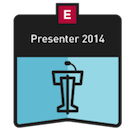
It's taken a while, but I am beginning to see real value in Second Life (SL) for educators. I've been a member of SL since 2006, but at first I spent very little time there. I just wasn't sure about a number of things, and I questioned its potential usefulness in higher education. I didn't want to use the technology just because I could, especially since it wasn't simple or intuitive to use for a nontechie beginner.
There were two main reasons I kept going back in and didn't give up on SL when others in higher ed said I was wasting my time. Number one - it makes a lot of sense economically. In our globally connected digital world more students than ever before are looking to online education. Here is a post with statistics from the Sloan Consortium on growth in online learning.
Using Second Life or other virtual worlds to help facilitate teaching and learning can save universities money while providing students a richer experience than more traditional online learning systems.
How can I confidently make the above statement? I attended graduate school through a hybrid program at UIUC, graduating in 2004. They used what, at the time, was considered cutting edge online technology to deliver courses to the students in my cohort from all over the world. We also met on campus once a semester. I was very satisfied with my experiences through that program and have been using that standard to evaluate my experience with teaching and learning in SL.
And this brings me to the second main reason I believe virtual worlds will take off in higher ed. When comparing my experience in a high quality hybrid graduate program using traditional online systems with my experiences attending discussions and classes in SL, I can now say without hesitation that my experience in SL has been richer. I'm still reflecting on exactly why and how that is so. Partly it's the ability to easily connect with others, and at a potentially deeper level.
Recently, I have been attending discussions/classes on information literacy led by Sheila Yoshikawa (Sheila Webber in RL) from the University of Sheffield. Sheila is Director of the Centre for Information Literacy Research at the university. She publishes and runs workshops on information literacy and on SL as a learning environment. Shelia's group discussions are small (averaging from 7-15 students) and I believe I am the only one from the USA. I am getting to know some of the regulars and Sheila a little better. I am very interested in making global connections of this sort for many reasons. It is helpful to hear the more diverse viewpoints and I believe it can lead to opportunities to expand my research interests. But there is more than that. It is easier to collaborate in various ways. And it feels different. Even though my online hybrid graduate school was in real time, and therefore much like SL in that way, not seeing the other students, not interacting with avatars in the way you can in SL made a difference. It is a richer experience, one that may need to be experienced to fully understand.
I have also attended a few other events and classes where I have been able to see how new technologies are now being implemented within SL in new ways. Ways that better serve educators. Enabling voice in SL a few months ago was important, and others are working to provide ways to incorporate technologies that add value to the learning environment.
In an Educause (ELI) online conference I attended yesterday a prof was demonstrating a tool he developed for his art students, who have posted their art work in a gallery the prof provided for them in SL. This ELI session taught by Michael Connors, Associate Professor, Digital Printmaking, University of Wisconsin-Madison, showed him walking around live in his gallery in SL demonstrating his new tool, Critique_It, which "provides an environment for simulating authentic learning strategies and allowing the possibility for feedback from peers and experts from outside the campus." This is just one example of the types of technologies that educators are bringing into SL to create a learning environment that goes beyond what currently exists. There are many others.
New Media Consortium (NMC) is developing nicely in SL and providing opportunities for educators by offering some free space to get started. An event at NMC in SL on Monday demonstrated new technologies for video in SL that was most impressive. It drew a large audience which included many educators. I believe many educators are only recently beginning to understand the potential that exists within virtual worlds. I do believe they will continue to develop, whether in SL or other immersive education environments.
The snapshot I included here is of me attending a recent Information literacy discussion at the University of Sheffield in SL. For now, I am a male with orange hair in black. I am sitting next to the prof with blue hair. Click image to enlarge.


